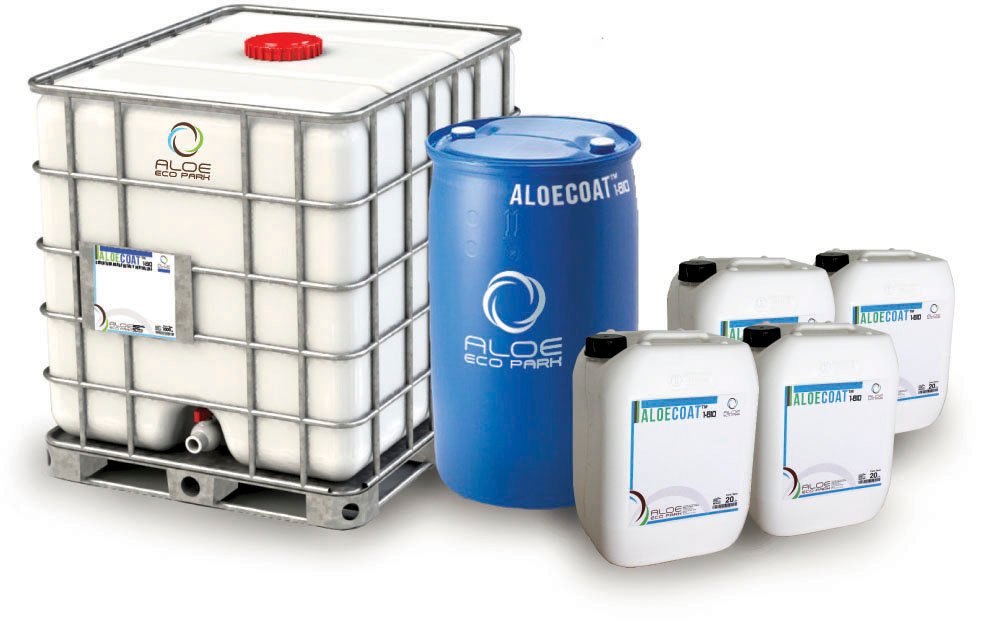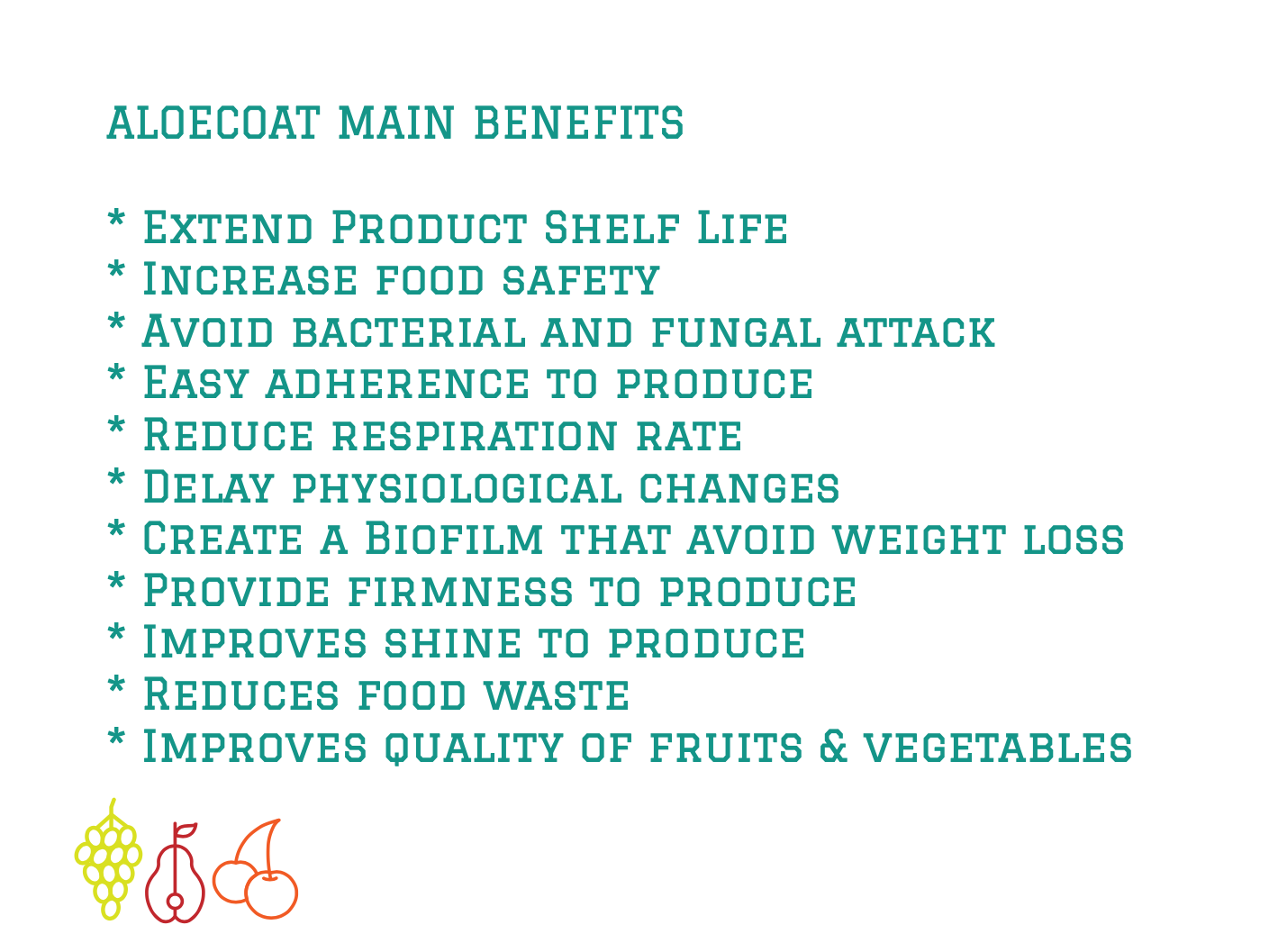Advantages of AloeCoat for Fruits and Vegetables
AloeCoat is a 100% natural, plant based edible coating for use in fruits and vegetables.
AloeCoat is made from purified extracts of aloe compounds, creating a biofilm on fresh produce, reducing respiration and perspiration, protecting from fungi and bacteria and thus extending shelf life of the products.
While it is true that AloeCoat offers a definitive solution to the great problem of food waste, it actually offers different solutions to each participant in the fruit and vegetable chain.
AloeCoat offers different advantages and benefits to producers, packaging, brokers, distributors, importers and consumers as a whole. Below we explain the main advantages of the product and to the different actors in the fresh produce chain.
1. Advantages of Our Edible Coating for Fruits and Vegetables Compared to Traditional Waxes
Strictly speaking, our product has an indirect competition with waxes, since vegetable, animal or mineral based waxes only provide preservation or polishing functions, but do not offer antibacterial or anti fungal functions.
Within this category, vegetable waxes are the most accepted in the market, since animal waxes are expensive (beeswax for example), and mineral waxes, as they come from petroleum, have a bleak future, since consumers tend to demand healthier products every day and therefore, they demand the elimination of waxes and food coatings from petroleum based materials, as it is the case with paraffin based waxes.
However, our AloeCoat edible coating is a green and sustainable option, not compared to conventional waxes, since it offers more benefits and advantages not only to the fruit or vegetable but to the food chain too (including commercial and logistic phases), as explained below.
When compared to waxes, our technological solutions contributes to climate change efforts. AloeCoat minimizes food waste and food loss, improving food safety and quality, thus saving a high volume of GHG emissions.
2. Advantages of our Edible Coating for Fruits and Vegetables compared to controlled atmosphere bags
Our technological solutions has also indirect competition with controlled atmosphere bags. This product only offer shelf life extension to fruits and vegetables, but do not offer anti fungal or antibacterial functions like our aloe-based solution.
The plastic bags offers protection in the complete packing, i.e. to the overall set of fruits that are packed inside the bag, but does not offer individual protection to each product.
The problem is, when an individual fruit is contaminated with fungus, the result is that a large percentage of the fruit packed in a controlled atmosphere bag is immediately contaminated.
By opposition, our products do not allow such fungal contamination. AloeCoat offers a shelf life extension, an antibacterial and anti fungal function, but those advantages are granted to each fruit or vegetable individually, since the coating cover each fruit and vegetable in particular, while the bag offers general protection, that is, the set of fruits and vegetables inside a box.
Besides it, the bag still is a plastic, and there is another problem for its disposal, causing concerns and damage to environment. AloeCoat is green and sustainable, environmentally friendly, having positive impact on the environment.
This allow AloeCoat to be at the forefront compared to other products in terms of advantages and benefits for the preservation of fruit and vegetables.
That is why we say that AloeCoat has no specific direct competition.
There is a long list of advantages of our Aloe based coating. In the conservation of vegetables and fruits, our products prolong the shelf life of the treated products, which allows increasing profitability, while reducing the cost for fruit and vegetable packaging companies, since they combine the function of wax with the added value of bactericidal, antiseptic and anti fungal properties.
3. Economic Advantages of using AloeCoat
Our product offers various advantages and benefits to all participants in the food chain. In general, there is a tendency to think that the advantages in the use of our product reach the agricultural growers or the fruit and vegetable packing companies.
This is correct, but these benefits also reach the other participants in the value chain, reaching the final consumer.
In other words, the benefit of using our AloeCoat for the protection of fruits and vegetables goes from the producer to the final consumer. From farm to the fork.
Very few products can account for such a wide range of benefits, and above all, that these benefits reach all the participants in an industry, reaching the consumer until the end user. This happen with AloeCoat.
Advantages for Fruit and Vegetable Producers
- AloeCoat extends the life of the product, so there are fewer rejects and returns, and the producer receives increased sales revenue and income.
- The use of AloeCoat allows the producer to reduce the cost to purchase bactericides, antiseptic and anti fungal products, since our coating provides antibacterial, antiseptic and anti fungal functions.
Advantages for Fruit and Vegetable Packing Companies
- Lower associated cost, higher sales revenue, therefore higher profitability for the business.
- AloeCoat allows products to be better preserved when they have long transportation journeys by truck, rail, ship or plane, meaning fewer losses and higher sales revenue and income.
Advantages for Brokers, Distributors and Importers of Fruits and Vegetables
- AloeCoat extends the life of the product, which means fewer rejections and returns, and the broker has a greater margin for selling more products.
- The use of our coating allows the broker to have less product loss due to contamination or fungal attacks, a situation that can occur frequently and that affects an important part of the shipments, reducing their final volume for sale.
- With AloeCoat, the broker, distributor or importer has a greater opportunity to sell shipments and full loads, generating higher sales revenue.
Advantages for Fruit and Vegetable Retailers – Hypermarkets, Supermarkets, Stores and Retail Markets
- AloeCoat extends the life of the product, which means fewer rejections and returns.
- The retailer has lower administrative and logistical costs involved in the merchandise return process, and it has more opportunity to sell all the product received, generating higher sales.
- The use of our coating allows the retailer to receive the merchandise in good condition, without damage from bacteria or fungi.
- The retailer can keep their product fresh and in good condition.
- The retailer has no complaints about the use of polluting products such as mineral waxes.
- The retailer has no disposal costs for controlled atmosphere bags. The bags are made with polyethylene that comes from petroleum, and must be confined, which generates a cost for the retailer. With AloeCoat, retailers do not have such disposal costs as it happens with the controlled atmosphere bag.
- AloeCoat is biodegradable in a matter of minutes. On the contrary, Xtend type controlled atmosphere bags are degradable in a period close to 400 years!!!
- With the use of AloeCoat, the retailer can show an environmental friendly approach before society and related communities, which adds value to its company. This situation does not happen with conventional coating products.
Advantages for Fruit and Vegetable Consumers
- AloeCoat extends the life of the product, so there is less risk that a decrease in supply will raise the price of the product and harms the consumer.
- The use of our coating does not increase the price of the product, so the consumer receives benefits without paying a higher price for it.
- AloeCoat is a natural product, green and sustainable option, which is highly and widely valued by consumers.
- AloeCoat is manufactured with renewable resources, generates a positive environmental impact, is a totally sustainable product, friendly to the environment, and manufactured under the process of a socially responsible company, which gives a higher value to consumer satisfaction.


